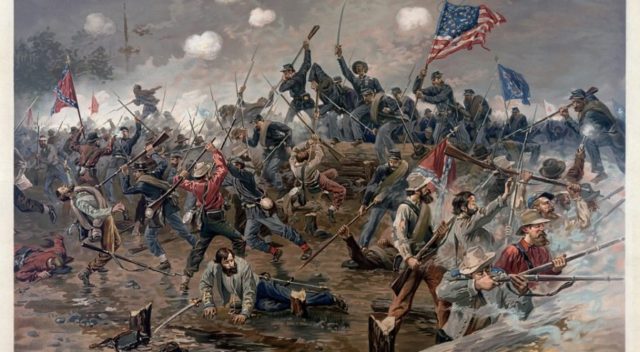NOTE: this is one of those posts which will please some and anger others, however to offer the good, the bad and the ugly – as we have promised to do – we post the following to demonstrate a mind-set within the education system – and more – from outside of it. We would like to witness this author teaching in a classroom. ~ Ed.
 In the fall of 2014, hundreds of high school students in Jefferson County, Colorado, walked out of class to protest their newly elected conservative school board’s proposed curriculum-review committee calling for the promotion of “positive aspects” of the United States and its heritage and the avoidance of material encouraging “civil disorder, social strife or disregard of the law.” The proposed committee was also to be charged with ensuring that Advanced Placement (AP) US History materials “promote citizenship, patriotism, essentials and benefits of the free enterprise system, respect for authority and respect for individual rights.”
In the fall of 2014, hundreds of high school students in Jefferson County, Colorado, walked out of class to protest their newly elected conservative school board’s proposed curriculum-review committee calling for the promotion of “positive aspects” of the United States and its heritage and the avoidance of material encouraging “civil disorder, social strife or disregard of the law.” The proposed committee was also to be charged with ensuring that Advanced Placement (AP) US History materials “promote citizenship, patriotism, essentials and benefits of the free enterprise system, respect for authority and respect for individual rights.”
The furor over the local proposal occurred within a larger national debate over the College Board’s revised AP US History guidelines, which the Republican National Committee condemned for emphasizing “negative aspects of our nation’s history.” The tension over curriculum choices illustrated the profoundly contested nature of history’s role in the classroom and larger American society. Though social studies courses hold the potential to cultivate informed and engaged citizens of the ideal type we imagine to participate in democracies, the US school system currently functions to alienate students from the historical material they are studying and offer them a misleadingly limited view of the past. In doing so, we are sacrificing an opportunity to help students develop a critical and thoughtful view of history and society that has become all the more necessary in a time of open, growing resentment toward liberal institutions.
Students have expressed a general antipathy toward social studies courses: When asked in 2013, only three percent of respondents to a Gallup poll ranked social studies — a subject area that includes history — as the school subject that had proved most valuable to them in their lives; eight percent of respondents selected history. An Institute of Education Studies report from 1982 evinces the deep roots of this trend, observing “largely indifferent or negative attitudes toward social studies subjects” among surveyed students. The long-term impacts of this student disaffection ought to trouble us: The Leonore Annenberg Institute for Civics reports that students who experience “effective civic learning” (defined as interactive, stimulating debate, encouraging creative thinking, and immersing students in questions of contemporary relevance) are more likely to vote and to discuss politics in the home, are more confident in their public speaking ability and capacity to communicate with elected representatives, and four times more likely to volunteer in their communities. Indeed, the platitudes of civic education making for engaged citizens hold true, as far as we can measure their existence empirically; a lackluster performance of history courses in engaging high schoolers represents a substantial risk to the functioning of the democratic state.
Much of this pattern may be attributable to history teachers possessing, on the whole, less rigorous qualifications than teachers of most other subjects: For example, in the 2011-12 school year, while only two percent of music teachers lacked both a degree in the field and a certification to teach it, a third of history teachers lacked both credentials. This dilemma likely stems partially from state licensing standards: No state requires candidates to possess a major or minor in US history to teach it. Unfortunately, teachers lacking a background and inherent interest in history may rely rather heavily on textbooks rather than key primary source documents from various periods, a trend that creates both student distaste toward the rote style of instruction and constructs a woefully incomplete vision of the US’ past.
The language of states’ rights as the drive for southern secession is not simply an additional vantage point from which to conceptualize the reasons for the Civil War; it is a perspective that explicitly omits the southern commitment to slavery.
It would likely not come as a shock to those who have witnessed the unfolding of the movement for black lives and various high-profile cases of police brutality that the American history taught in many classrooms erases much of the brutal racism animating the nation’s construction. A key contributor to this pattern lies in textbooks and the distorted market for instructional materials. The state of Texas purchases nearly 50 million textbooks annually, wielding a consumer power rivaled only by California, and — crucially — this shapes the material selected for publication by textbook vendors. Not wanting to lose sales in a state with high school educational standards requiring students to identify Moses as a primary influence on founding American documents, textbook creators elide many of the most overt examples of racism and other forms of bigotry in the historical record and sell this material, shaped for flawed Texas standards, to schools across the nation. It was out of this backdrop that McGraw Hill received a deluge of criticism for referring to slaves forced into migration and labor as “workers,” a choice of words publicized online after a Texas student snapped a photo of the text.
The Lone Star State’s fraught relationship with educational texts reflects the larger erasure of racial oppression in history courses. Many textbooks mystify and obfuscate the origins of the Civil War; for example, the best-selling textbook The American Journey describes southern secession as follows: “Many people in the South mistrusted the [Republican] party, fearing that the Republican government would not protect Southern rights and liberties. On December 20, 1860, the South’s long-standing threat to leave the Union became a reality when South Carolina held a special convention and voted to secede.” The language of states’ rights as the drive for southern secession is not simply an additional vantage point from which to conceptualize the reasons for the Civil War; it is a perspective that explicitly omits the southern commitment to slavery.[1] To move beyond textbooks to the crucial historical documents of this period — documents most high school students are not studying — the impetus for succession was explicitly delineated in state declarations of departure from the union. Texas’ declaration proclaimed an unadulterated loyalty to white supremacy: “We hold as undeniable truths that the governments of the various States, and of the confederacy itself, were established exclusively by the white race, for themselves and their posterity; that the African race had no agency in their establishment; that they were rightfully held and regarded as an inferior and dependent race, and in that condition only could their existence in this country be rendered beneficial or tolerable.” As James W. Loewen, Professor of Sociology at the University of Vermont, puts the matter: “Teaching or implying that the Confederate states seceded for states’ rights is not accurate history. It is white, Confederate-apologist history.” When history teachers depend upon textbooks written to avoid offending southern states with purchasing power, this racial apologist rendition of history reigns in high school classrooms. It is, perhaps, this reality that may partially explain (though certainly not entirely, for larger systemic factors are at play) the racial achievement gap in social studies subjects, which is substantial when measured by markers such as the National Assessment of Educational Progress. Christine Sleeter of the National Educational Association articulates the stakes of history classes dominated by whiteness and white views, writing: “As students of color proceed through the school system, research finds that the overwhelming dominance of Euro-American perspectives leads many such students to disengage from academic learning.”
Particularly given the substantial links between history and other social studies education and productive engagement in civic life in adulthood, the inadequacy of history textbooks (and, subsequently, courses) in addressing the role of racism in America’s national past becomes especially concerning during a period when racism has re-entered the public discourse in extraordinarily overt form. If we, as a society, want our current students to become adults dedicated to fighting racism in the political and social structures they inhabit, providing them with a history education that engages them in critical discussion of racism as an enduring facet — if not foundation — of the United States is one point at which to start. High school history educators ought to move in the direction of historiography as opposed to historical memorization, focusing on critical analysis of primary source documents within their temporal context and an understanding of history as a body of competing narratives rather than one storyline. Though more instrumental reforms are also necessary — such as altering the textbook market so that material is not purchased on the state level, granting some states disproportionate influence over the content of instructional material (in theory, this system could be replaced with a local or even teacher-centered decision process), and improving and standardizing credentials for history teacher candidates — an overall pedagogical transition to historiography with a critical awareness of race is urgently needed.
Written by Molly Naylor-Komyatte and published by the Brown Political Review ~ April 11, 2017
[1] The “omission of the southern commitment to slavery” has been presented in numerous postings within the pages of the Metropolis Café. There has been no intent to “omit” the issue – but to present evidence that “slavery” was not the prime reason for succession from the Union. ~ Ed.
 FAIR USE NOTICE: This site contains copyrighted material the use of which has not always been specifically authorized by the copyright owner. We are making such material available in our efforts to advance understanding of environmental, political, human rights, economic, democracy, scientific, and social justice issues, etc. We believe this constitutes a ‘fair use’ of any such copyrighted material as provided for in section 107 of the US Copyright Law. In accordance with Title 17 U. S. C. Section 107, the material on this site is distributed without profit to those who have expressed a prior interest in receiving the included information for research and educational purposes. For more information go to: http://www.law.cornell.edu/uscode/17/107.shtml
FAIR USE NOTICE: This site contains copyrighted material the use of which has not always been specifically authorized by the copyright owner. We are making such material available in our efforts to advance understanding of environmental, political, human rights, economic, democracy, scientific, and social justice issues, etc. We believe this constitutes a ‘fair use’ of any such copyrighted material as provided for in section 107 of the US Copyright Law. In accordance with Title 17 U. S. C. Section 107, the material on this site is distributed without profit to those who have expressed a prior interest in receiving the included information for research and educational purposes. For more information go to: http://www.law.cornell.edu/uscode/17/107.shtml
